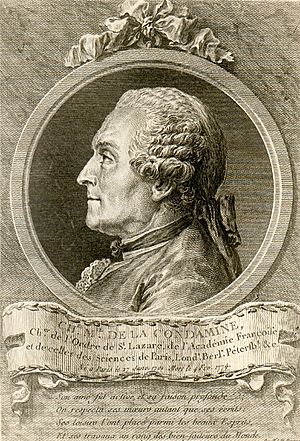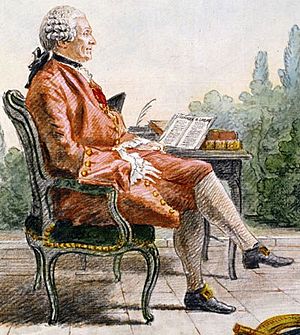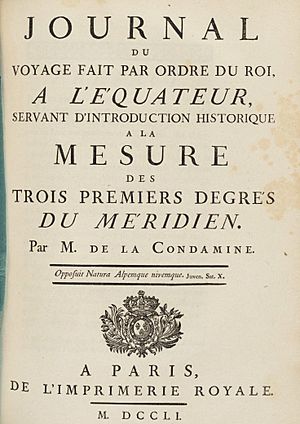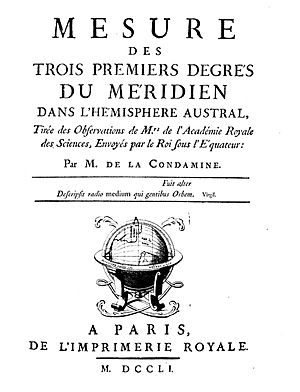Charles Marie de La Condamine facts for kids
Quick facts for kids
Charles Marie de La Condamine
|
|
|---|---|

La Condamine by Charles-Nicolas Cochin (1768) Pierre-Philippe Choffard (1759)
|
|
| Born | 28 January 1701 |
| Died | 4 February 1774 (aged 73) |
| Nationality | French |
Charles Marie de La Condamine (born January 28, 1701 – died February 4, 1774) was a famous French explorer, geographer, and mathematician. He spent ten years in what is now Ecuador. There, he measured the length of a degree of latitude at the equator. He also created the first map of the Amazon region. This map was based on careful astro-geodetic observations. He also helped write the Encyclopédie, a very important book series.
Contents
About La Condamine
Charles Marie de La Condamine was born in Paris, France. His parents, Charles de La Condamine and Louise Marguerite Chourses, were quite wealthy. He went to a good school called the Collège Louis-le-Grand. There, he studied subjects like history, literature, and math.
After school, he joined the army. He fought in a war against Spain in 1719. When he came back to Paris, he met many scientists. On December 12, 1730, he became a member of the Académie des Sciences. This was a very important science group.
In 1729, La Condamine and his friend Voltaire found a way to win a lot of money from a government lottery. This made them quite rich.
In May 1731, La Condamine traveled to Constantinople (now Istanbul) by ship. He stayed there for five months. When he returned to Paris, he wrote a paper for the Academy. It was about his scientific observations during his trip.
Journey to South America
Three years later, La Condamine joined a special trip to South America. This trip was called the French Geodesic Mission. Its main goal was to test an idea by Isaac Newton. Newton believed that Earth was not a perfect ball. He thought it bulged out at the equator and was flatter at the poles.
This idea caused a big debate among French scientists. So, two groups were sent out. One group went to Lapland (near the North Pole). The other group, including La Condamine, went to South America. They would measure the Earth's shape near the equator.
On May 16, 1735, La Condamine sailed from La Rochelle. He traveled with other scientists, including Louis Godin and Pierre Bouguer. They also had a botanist, Joseph de Jussieu, with them. They stopped in places like Martinique and Cartagena. Finally, they arrived in Manta, Ecuador, on March 10, 1736.
The expedition faced many problems. La Condamine often disagreed with his fellow scientists. Eventually, he decided to travel alone to Quito, Ecuador. He followed the Esmeraldas River. On this journey, he became the first European to see rubber. He even brought samples of rubber back to France in 1736. Later, he shared a paper about rubber's properties. This was one of the first scientific papers about rubber. He rejoined the group in Quito on June 4, 1736.
The scientists chose a high valley near the equator to make their measurements. It stretched from Quito in the north to Cuenca in the south. They spent a month using triangulation to measure distances. This was done in the Yaruqui plains in late 1736.
After returning to Quito, they found that money from Paris had not arrived. La Condamine had wisely saved some money in a bank in Lima. So, he traveled to Lima in early 1737 to get it. He used this trip to study the cinchona tree. This tree's bark contains quinine, a medicine used to fight malaria. He also collected seeds of other important plants like vanilla and cacao (used to make chocolate).
When he returned to Quito in June 1737, his colleague Godin refused to share his results. So, La Condamine teamed up with Bouguer. They continued their measurements in the difficult mountains near Quito. In 1741, they had a big argument over a math error. After that, they stopped talking to each other. But they both kept working separately. They finished their project in May 1743.
Coming Back to Europe
La Condamine did not have enough money to go straight back to France. So, he decided to return by way of the Amazon River. This route was much longer and more dangerous. His journey was the first scientific exploration of the Amazon. He reached the Atlantic Ocean on September 19, 1743. Along the way, he made many important observations about stars and the land. He also studied cinchona and rubber trees.
In February 1744, he arrived in Cayenne, the capital of French Guiana. France was at war at the time, so he couldn't sail on a French ship. He had to wait five months for a Dutch ship. He used this time to study local plants, animals, and people. He finally left Cayenne in August 1744. He arrived in Amsterdam in November and then in Paris in February 1745. He brought back many notes, plant samples, and art objects. He gave them to a famous naturalist named Buffon.
La Condamine published his findings and a map of the Amazon in 1745. This included the first European descriptions of the Casiquiare canal. He also wrote about curare, a poison used by Amerindians. He noted the correct way to use quinine to treat malaria. The story of his ten-year journey was published in 1751. The expedition proved that Newton was right: the Earth is indeed flatter at the poles.
La Condamine and Bouguer never wrote a book together. Bouguer died in 1758. La Condamine was the only surviving member of the main expedition team. Because of this, he received most of the credit for their discoveries. He was also a talented writer, which made his work very popular in France.
La Condamine also visited Rome. There, he carefully measured old buildings. He wanted to figure out the exact length of the Roman foot. He also wrote about many other topics, often related to his work in South America.
La Condamine had smallpox when he was young. This made him very interested in preventing the disease. He strongly supported variolation, an early form of inoculation against smallpox. He wrote several papers for the Academy of Sciences. He explained his ideas clearly and with great passion. He became a member of many science academies around the world. In 1760, he was elected to the l'Académie française, a very high honor. He married his young niece, Charlotte Bouzier, in 1756. La Condamine had many friends. His closest friend was Maupertuis, to whom he left his papers. La Condamine died in Paris on February 4, 1774, after an operation.
His Writings
La Condamine wrote many books and papers about his travels and scientific work. Here are some of his important works:
About South America
- Journal du voyage fait par ordre du roi à l'équateur (Paris 1751, with a supplement in 1752)
- Relation abrégée d'un voyage fait dans l'intérieur del'Amérique méridionale (Paris 1759)
Other Works
- La figure de la terre déterminée (Paris 1749)
- Mesure des trois premiers degrés du méridien dans l'hémisphère australe (Paris 1751)
- Histoire de l'inoculation de la petite vérole (Amsterdam 1773)
See also
 In Spanish: Charles Marie de La Condamine para niños
In Spanish: Charles Marie de La Condamine para niños




